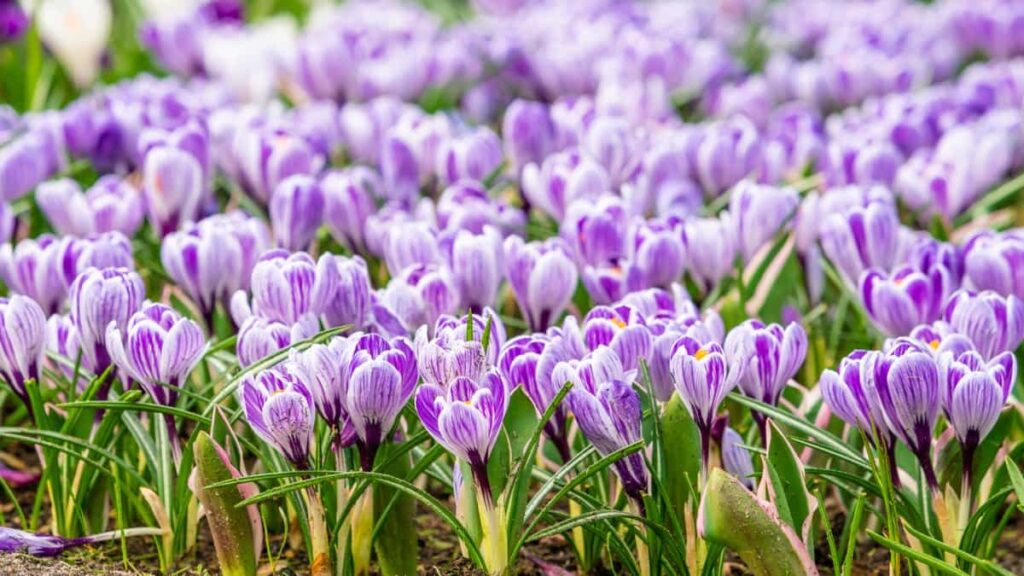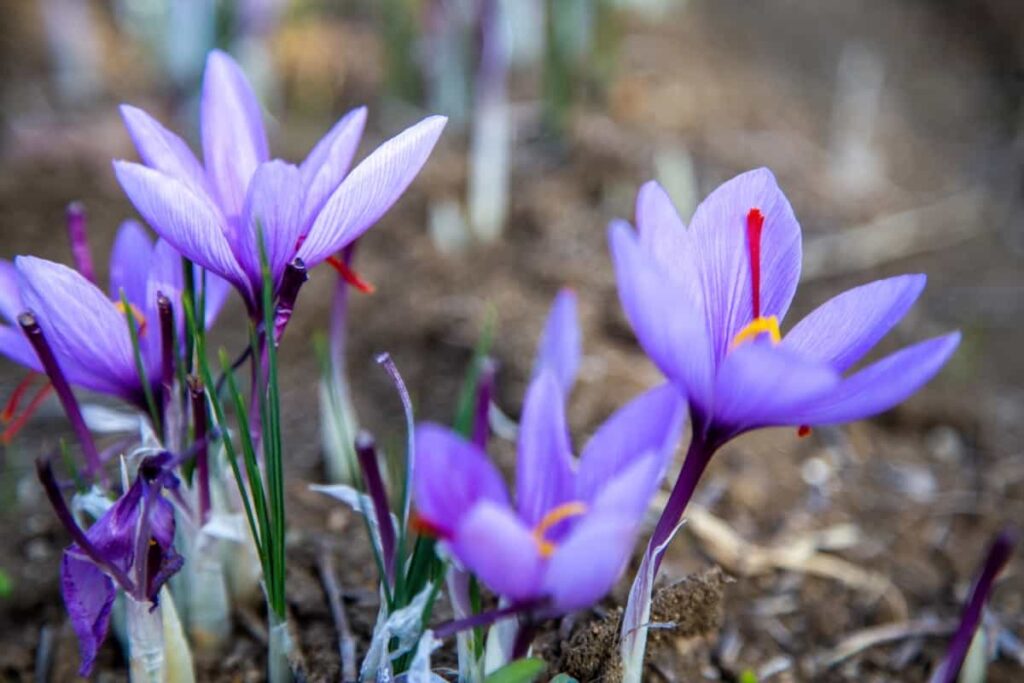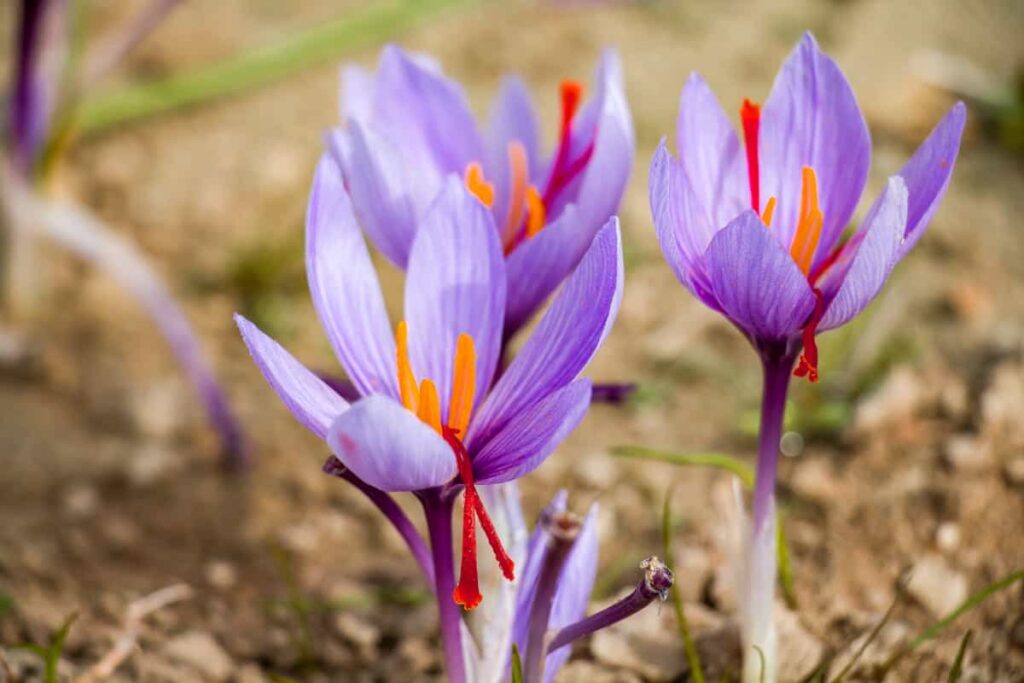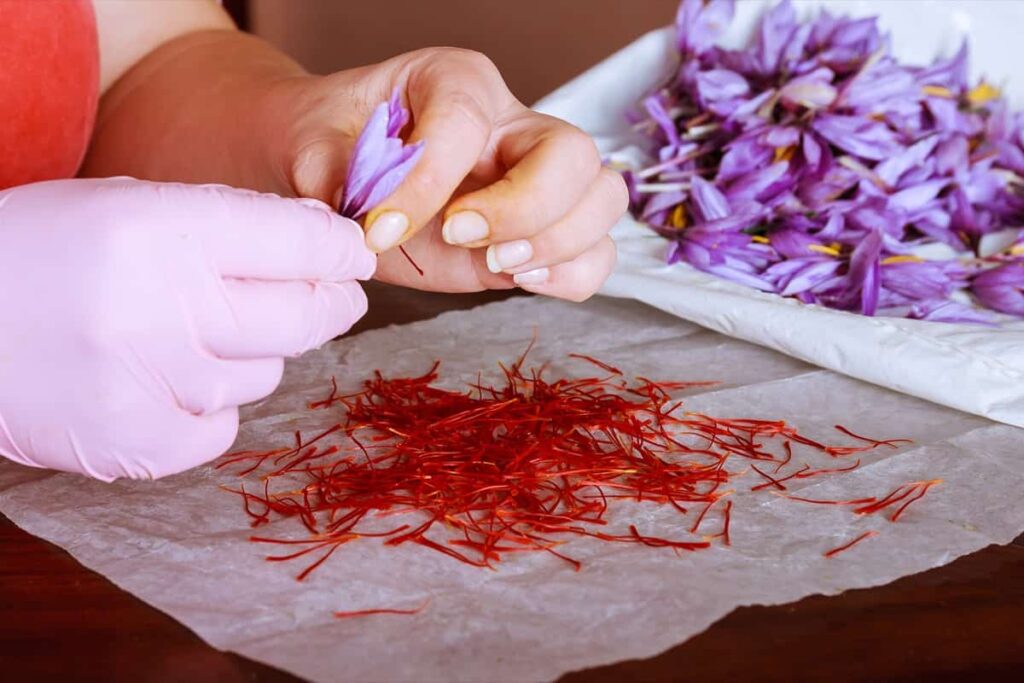Are you interested in saffron farming and looking to create a profitable business plan? This guide will cover your need to know about saffron farming, from its plant characters and benefits to how to grow and produce saffron. We’ll discuss the different varieties of saffron, the climate and soil required for successful cultivation, and the process of the saffron plantation, including manure and fertilizer use and techniques. We’ll also cover saffron pests and diseases, harvesting, and post-harvest operations, as well as provide a project report on saffron cultivation.

Saffron Farming Business Plan
Introduction to Saffron and Plant Characters
- Saffron (Kesar) is a spice made from the dried stigmas and styles of the Crocus sativus plant, often known as the “saffron crocus”. The brilliant crimson threads are collected, dried, and used in food as a spice and colouring enhancer.
- Saffron has been traded and used for thousands of years and is attested in a 7th-century BC Assyrian botanical treatise. Iran is currently the world’s largest producer of saffron, accounting for about 90% of the total production.
- The domesticated saffron crocus is an autumn-flowering perennial plant originating in Central Asia. Corms, underground, bulb-like organs that store starch, must be dug up, divided, and replanted for reproduction.
- The plant sprouts white and non-photosynthetic leaves known as cataphylls, which cover and protect the true leaves and bud and develop on the crocus flower.
- The true leaves are thin, straight, and blade-like green foliage, which are 1-3 mm in diameter. Its brilliantly hued flowers develop in October and vary from a light pastel shade of lilac to a darker and more striated mauve.
- The flowers possess a sweet, honey-like fragrance and bear a three-pronged style 25-30 mm long, each prong terminating in a vivid crimson stigma.
- It has a 3 – 4 month harvest cycle and can grow to 15-20 cm in height.
In case you missed it: Harvest Fresh and Healthy: Best Top 10 Vegetables for Terrace Garden/Rooftop Farming

Benefits of Saffron Farming
- Saffron is a valuable spice crop that can generate high revenue for farmers.
- It requires less water than other crops and can be grown in arid regions.
- Saffron farming can help boost the local economy and provide employment opportunities.
- Saffron has a wide range of uses, including as a flavoring and coloring component in milk, meat, and cheese, as well as in perfumes and cosmetics.
- In Ayurveda, saffron treats various health conditions such as arthritis, infertility, liver enlargement, and fever.
Commercial Saffron Varieties
Commercial saffron varieties include Spanish, Iranian, and Kashmiri saffron. Spanish saffron is known for its bright red colour and intense flavour. Iranian saffron, or “red gold,” is considered the highest quality saffron due to its potent aroma, strong colouring ability, and long threads. Kashmiri saffron is prized for its unique floral aroma and is often used in teas and desserts. Other varieties include Moroccan, Italian, and Greek saffron, each with a distinct flavour and colour profile.
Successful Saffron Farming Strategies-How to Grow Saffron for Commercial Production
Growing saffron requires suitable soil, climate, and proper plant care. Provides an overview of how to start a successful saffron farming business, from site selection to post-harvesting tasks. With the right knowledge and practices, you can turn your saffron cultivation into a lucrative source of income.
- Site Selection: Choose a site with acidic to neutral, gravelly, loamy and sandy soil. Soil should be well-drained, and the soil’s pH level should be between 6 and 8.
- Soil Preparation: Preparing the soil is crucial. Ensure the field is weed-free, and add organic matter to the soil. Perform a couple of ploughings to bring the soil to the fine tilth stage and loosen the soil before planting the corn for better growth. Before ploughing, apply 20 tonnes of cow dung, 90 kg of nitrogen, 60 kg of phosphorus, and 60 kg of potassium per hectare.
- Climate Requirement: Saffron can tolerate cold winters, tolerating frosts with a low temp of −10 °C, and short periods of snow cover. Winter is the vegetative growth, and leaves will be dried in May. Saffron grows in sunken and dry areas at 1500-2500m. It requires a 12-hour photoperiod which is beneficial but sometimes delays flowering.
- Best Time for Saffron Cultivation: The best time for planting saffron is between June and September. It demands great heat and dryness in the summer and extreme cold in the winter.
- Propagation: Propagation in saffron is through compressed underground stems (corms).
- Corms: You must purchase corms from the market for commercial saffron production. You can order them online as well.
- Planting: Plant saffron corms directly in the field or in pots for small-scale production or home garden. Plant the corms 12 to 15 cm deep with a 10-12 cm space between them. Irrigation is not required after planting. However, depending on the soil moisture content, irrigation can be done during protracted droughts and hot seasons. Saffron corms generally multiply yearly, with one corm producing five corms after three years of planting.
In case you missed it: Vertical Saffron Farming: The Red Gold Revolution for Excellent Profits

- Caring: Saffron plants are hardy and require less caring, but additional care will help the plants to grow well and produce more.
- Fertilizing: Apply adequate organic fertilizers during land preparation. Applying 80 kilogram P, 30 kg K, and 20 kg N per hectare is beneficial annually. Apply these fertilizers in the fall and again right after flowering.
- Watering: Irrigation is required immediately following planting. However, watering might be done in a lengthy drought and hot season based on the soil moisture content. Weekly irrigation is performed, and 283 m cubic per acre of water must be given during the crop cycle.
- Mulching: Mulching helps to hold moisture in the soil and also helps to control weeds. You can use organic materials for mulching.
- Controlling Weeds: Mulching with organic material will prevent most weeds. Regular hand weeding is necessary, and weedicides can be effective in commercial production.
- Pests and Diseases: The saffron plant is susceptible to some common pests and diseases, such as Fusarium, Rhizoctonia crocorum, and Violet root rot. It is also recommended not to be used again for 8-10 years.
In case you missed it: Harvest Fresh and Healthy: Best Top 10 Vegetables for Terrace Garden/Rooftop Farming

- Harvesting: Flowering generally starts in October and lasts for a month. Harvesting should occur when the flowers are in full bloom, and early morning picking is preferred. Extract the red pistils of the flowers after harvesting them. The saffron flowers must be harvested before sunrise, and the stigmas are sun-dried for 5-6 days or dried in solar driers for 7-8 hours.
- Post-Harvesting Tasks: Filaments can be dried on a sieve in a well-ventilated area for 15 minutes. Fresh saffron has no taste. Therefore, dried saffron should be stored in an airtight container away from light for at least one month before use.
- Yield: It takes 150-160 flowers to yield 1 gram of dried saffron. In the first year of planting, 60-65% of corms produce one flower each, while subsequent years see each corm producing about two flowers.
Project Report on Saffron Cultivation
Saffron is a valuable spice crop with immense medicinal properties that has been used in Indian cuisine and traditional medicine since ancient times. It is commercially grown in the Pampore and Kishtwar regions of JKUT, and its commercial activity is referred to as the ‘Golden Zest’ due to its high value. Saffron has played an essential role in rituals, traditions, and religions and is widely used in the food, textile, perfume, and cosmetics industries.
Its medicinal properties are also widely recognized, and it is used as an antiseptic, antispasmodic, anticancer, antidepressant, and an essential ingredient for curing respiratory problems. The delicate dried saffron threads are the stigmas and styles plucked from crocus flowers, and its high cash value has earned it the name ‘Golden Condiment’ worldwide.
The project report on saffron cultivation involves analyzing the total cost, expected returns, and profits. The total cost of cultivation includes land preparation, planting, labour, fertilizers, pesticides, irrigation, and other miscellaneous expenses. The total cost of saffron cultivation in one acre of land in India ranges from INR 6-7 lakhs or approximately USD 8,100-9,400. The expected yield of saffron per acre is approximately 5-6 kgs, and the market price for saffron ranges from INR 2-3 lakhs or approximately USD 2,700-4,050 per kg.
Therefore, the expected returns per acre of saffron cultivation are approximately INR 10-18 lakhs or approximately USD 13,500-24,300. After deducting the total cost of cultivation from the expected returns, the profit per acre of saffron cultivation ranges from INR 3-11 lakhs or approximately USD 4,050-14,850. The components contributing to the cost of cultivation are mainly labour, irrigation, and fertilizers—however, the cost of labour accounts for most of the cost of cultivation.
In case you missed it: Rosemary Farming Business Plan: A Step-by-Step Guide to Growing and Selling Profitable Herbs

Market Research and Analysis
- The saffron farming business is expected to grow over the next few years due to increasing demand from the pharmaceutical sector and rapid population expansion. The global saffron market was valued at INR 65,5370 Crores in 2019, and it is projected to grow at a revenue-based CAGR of 7.3% from 2020 to 2027.
- Saffron is an expensive spice used in different applications, including food, beverages, and medicines. Primary demand comes from herbal remedies, perfumery, textile dyeing, and cooking spices. Medicinal applications are expected to remain a key focus area for market vendors due to their use as an antidepressant, antioxidant, and antiseptic.
- However, the saffron market is expected to face challenges due to increasing labour costs, specific cultivation requirements, and high product prices. Lack of integration in the supply chain may also create challenges in the distribution network, hindering the expansion of the saffron market.
- The rapid development of the cosmetics industry, increasing population, and improved standard of living will likely boost the demand for saffron in the coming years. The growing demand for anti-blemish creams, fairness creams, and cleansers is also expected to be a key driving factor for the market.
Commercial Saffron Farming Business Plan
Commercial saffron farming can be profitable if planned and executed correctly. The first step in a saffron farming business plan is to select the right location for growing saffron, which should have a dry and hot climate with well-drained soil. The next step is to choose the appropriate saffron variety and source high-quality corms or bulbs. The planting process should be done in late summer or early fall, and the saffron flowers can be harvested in the following autumn.
Saffron requires careful attention to irrigation, fertilization, and pest control to ensure a healthy crop. After harvest, the saffron stigmas must be carefully processed and dried before packaging for sale. Saffron prices vary greatly depending on quality and market demand, but high-quality saffron can fetch a high price. A successful commercial saffron farming business can benefit from value-added products like saffron oil, powder, and tea.
Business Plan Components of Saffron Farming
A well-crafted business plan is essential for the success of any commercial saffron farming operation. A saffron farming business plan should include several key components to ensure a clear and effective strategy.
In case you missed it: Goat Farming Project Report: Investment, Profit for 10, 20, 50, 100, and 500 Goats

- Executive Summary: This section provides a brief overview of the saffron farming business, including its mission, objectives, and unique selling proposition.
- Market Analysis: A comprehensive market analysis is essential to understand saffron products’ current and potential demand. This section should include information about target customers, competitors, and market trends.
- Products and Services: This part should detail the various saffron products and services that the business will offer, including saffron bulbs, dried saffron, saffron powder, and saffron-based value-added products like saffron oil and tea.
- Marketing and Sales Strategy: This section should outline the marketing and sales tactics used to promote and sell saffron products. It should also include information about pricing strategies, distribution channels, and promotional activities.
- Operations Plan: This section describes the day-to-day operations of the saffron farming business, including planting, irrigation, fertilization, pest control, and harvest processes.
- Financial Plan: A detailed financial plan is crucial to the success of any saffron farming business. This section should include information about start-up costs, revenue projections, expenses, cash flow, and profitability.
- Management Team: This section should detail the experience and qualifications of the management team responsible for running the saffron farming business.
- Risks and Contingencies: This section should identify potential risks and challenges the saffron farming business may face and outline contingency plans to mitigate those risks.
Conclusion
A comprehensive saffron farming business plan is crucial for maximizing the success of any saffron farming operation. By addressing key components such as market analysis, marketing and sales strategy, and financial planning, farmers can develop successful saffron farming strategies to maximize their harvest and profitability.
- How to Raise Pigs in Your Own Backyard: A Comprehensive Guide
- Budget Friendly Sheep Shed Ideas: Cheap and Low-Cost Tips
- How Much Do Cattle Farmers Make: Revenue Streams in Cattle Farming
- Management Pests and Diseases in Your Cotton Field
- Sheep Farming Business Plan for Beginners
- Aquaponic Farming at Home: A Step-By-Step Guide
- Profitable Village Farming Business Ideas in 2024
- High-Yield Aquaculture: Fast-Growing Fish for Farming
- Effective Fish Pond Construction Techniques for Beginners
- Irrigation and Water Management in Pineapple Farming
- Blossom to Harvest: Mastering Flowering and Pollination in Papaya Farming
- Pig Fattening Essentials: From Selection to Sale for Beginners
- Raising Wagyu Cattle: A Complete Guide for Premium Beef Production
- Soil Types and Their Water Holding Capacity
- Optimizing Irrigation Schedules for Coconut Groves for Enhanced Yield
- Espresso Your Garden: Coffee Grounds for Healthier Acid-Loving Plants
- The Best Soil Mix for Snake Plants: How to Mix Your Own Snake Plant Soil
- Green Thumb Success: Expert Tips for Cultivating Greenhouse Beans All Year Round
- Bloom All Year Round: The Ultimate Guide to Indoor Hyacinth Care
- Eco-Friendly Gardening: How to Make Liquid Fertilizer from Kitchen Waste
- Ultimate Guide to Grow Anise in Pots: Explore Seed Propagation to Harvesting
- Guide to Raising Chester White Pigs: Discover Breed Facts to Growth Management
- Mastering the Elegance: The Ultimate Guide to Weeping Cherry Tree Care, Planting, and Maintenance
- Ultimate Guide to Planting Garlic in Grow Bags: Growing Strategies for Beginners
- How to Fix Spider Plant Leaf-Related Problems: Natural and Organic Remedies
- 10 Reasons Why Your Tulsi Plant is Shedding Leaves: Home Remedies and Solutions
- Optimizing Growth and Yield: The Advantages of Palm Bunch Ash Fertilizer
- Utilizing Neem Oil Extract as a Natural Pesticide for Hydrangea
- From Soil to Harvest: Various Ways in Which Farmers Can Use AI Tools
- Steps to Encourage and Induce Citrus Flowers: A Comprehensive Guide
- How to Fix Snake Plant Leaf-Related Issues: Natural and Organic Remedies
- Transform Your Garden into a Fragrant Oasis with Raat Ki Rani (Night Blooming Jasmine)
- Discover the Ideal Chicken Breeds for Philippine Farms
- How to Create a Poultry Egg Farm Business Plan for Profits
- Grow Lemon Cucumbers Like a Pro: Insider Techniques for Bountiful Yields
- Ultimate Guide to Caring for Your Pink Princess Philodendron: Tips for Thriving Variegation
